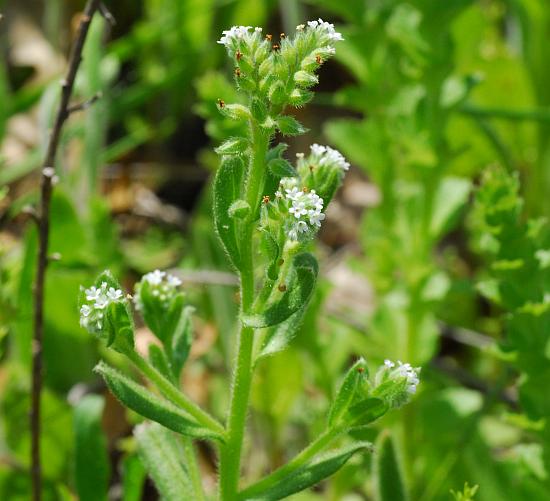Myosotis verna Nutt.

Native
CC = 2
CW = 3
MOC = 80
© SRTurner
Myosotis verna Nutt. | |
 |
Native CC = 2 CW = 3 MOC = 80 |
© SRTurner |
|
Family - Boraginaceae Habit - Annual forb with slender taproots. Stem - Ascending to erect, to 35 cm, not rooting at the lower nodes, solitary or occasionally few, usually unbranched below the inflorescence, moderately to densely pubescent with fine, loosely ascending to spreading, usually minutely pustular-based hairs, these not hooked at the tip.
Leaves - Alternate, simple, sessile. Blades 1-5 cm long, 3-9 mm wide, lanceolate to oblanceolate, rounded or angled to a bluntly or sharply pointed tip, the surfaces and margins densely pubescent with fine, loosely ascending to spreading, minutely pustular-based hairs, these not hooked at the tip.
Inflorescence - Scorpioid, spikelike racemes, sometimes aggregated into small panicles, the flowers with stalks 0.5-1.5 mm long at flowering, elongating to 2-4 mm at fruiting and erect to strongly ascending (mostly appressed to the axis) at fruiting with a strong bend at the tip, the inflorescence with linear, leaflike bracts at the branch points and lowermost flowers.
Flowers - Calyces 1.5-2.0 mm long at flowering, elongating to 3-6 mm at fruiting, slightly zygomorphic at flowering but becoming nearly 2-lipped at fruiting, 5-lobed slightly less than to slightly more than 1/2 of the way to the base, the 3 upper lobes shorter than the 2 lower lobes, especially at fruiting, triangular, densely pubescent with short, appressed, straight hairs and scattered, longer, spreading hairs that are mostly not hooked at the tip. Corollas actinomorphic, 2-3 mm long, broadly funnelform to trumpet-shaped, the tube 1.4-2.0 mm long, the spreading portion 1-2 mm in diameter, white. Stamens inserted toward the base of the corolla tube. Style 0.2-0.3 mm long, shorter than the nutlets.
Fruits - Schizocarps breaking into 4 nutlets 1.2-1.5 mm long, greenish brown to dark brown.
Flowering - April - June. Habitat - Prairies, glades, ledges and tops of bluffs, savannas, forests, pastures, railroads, roadsides, and open, disturbed areas. Origin - Native to the U.S. Lookalikes - M. macrosperma. Other info. - This inconspicuous little plant occurs throughout Missouri, with the possible exception of the northwestern corner of the state. Its distribution within the continental U.S. comprises two distinct regions, one in the eastern half of the country and the other in the Northwest. The plant is fairly easily recognized by its scorpioid inflorescences of tiny white flowers and bristly calyces. However, it can be easily mistaken for its strong lookalike M. macrosperma. The two are usually differentiated by the position of the fruit stalks, which are erect and appressed to the inflorescence axis in this species, but angled outward in M. macrosperma. Some references also note the calyx bristles which are mostly straight in this species, and mostly hooked at the tip in the case of M. macrosperma. Photographs taken at Little Lost Creek Conservation Area, Warren County, MO, 4-19-2012, Tucker Prairie Natural Area, Callaway County, MO, 5-1-2020, Riverfront Park, Washington, Franklin County, MO, 5-21-2021, and near Labadie, Franklin County, MO, 5-5-2025 (SRTurner). |